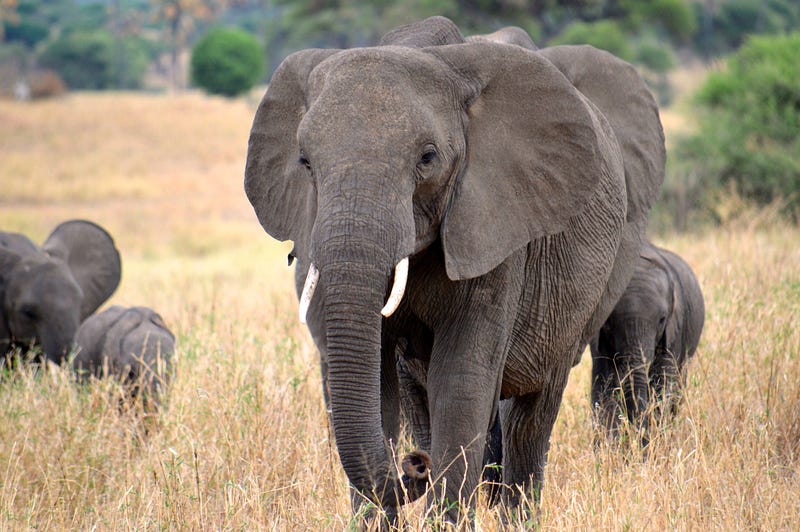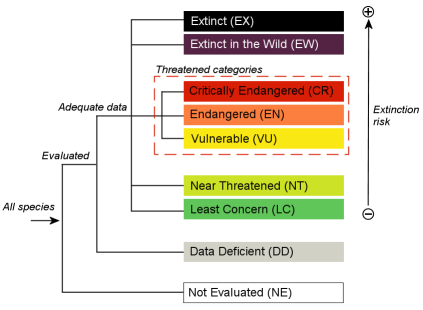Welcome back, everyone. I hope you haven’t missed my stories too much over the last month. However, the time off gives me a good opportunity to plan ahead for the upcoming season, both deciding on a broader theme and the overall structure of the different stories throughout.
As with the first story of last season, this week I am going to focus on introducing the topic and getting some definitions out of the way so that we all understand what certain terms mean when I use them later on. I’m also going to give you a preview of the overall structure of Season 3.
As you can tell from the story subtitle, the topic for this season is going to be endangered species. I have mentioned this topic before several times, but my focus for this season will be a bit different. When you hear the phrase ‘endangered species’, what image pops up in your mind? For most people, it will be one of a large and likeable animal, such as those pictured below (the African bush elephant, Loxodonta africana, and the African lion, Panthera leo).


In the scientific and environmental communities, we call these species ‘charismatic megafauna’. Charismatic means “exercising a compelling charm that inspires devotion in others”, fauna means animals and the prefix mega- means large. Thus, these are large animal species that are charming and inspire devotion. Such species often have widespread popular appeal and are easier to use in order to galvanize support for conservation. While most of these are mammals, the term also includes my personal favorite group of animals: sea turtles.
Season 3 will not be focusing on charismatic megafauna. Instead, we will be discussing, for the most part, some of the smaller and less popular species that are at risk and just as, or even more, important than the larger animals. Charismatic megafauna are useful for driving conservation awareness, but they can overshadow other examples. The goal of this season isn’t to raise awareness as much as it is to share the diversity of life and let some of the more ignored species a little time in the spotlight.
Before we discuss any particular species, we need to talk about terms and definitions. I know this isn’t always the most fun part of storytelling, but it is important, especially for this season. Certain words often have different connotations when used in a scientific context compared to a colloquial context. This is no more evident than in the word ‘theory’ (colloquially it means a guess, but in the sciences it is an explanation for aspects of nature based on observed data that has survived rigorous testing). I want to avoid confusion and make sure we’re all on the same page.
For this season, I will be using terms created by the International Union for the Conservation of Nature (IUCN). The IUCN publishes the Red List of Threatened Species, a comprehensive approach for objective evaluation of species conservation status. I will be using the terms that the IUCN has created for each of the species I highlight in the next twelve weeks. I am including the simplified definitions for each of them here for easy referral. There is a diagram below the definitions that shows how each term relates to one another.
Not Evaluated
A species that has not been evaluated by the criteria set forth for classification in one of the other categories.
Data Deficient
A species for which there are not sufficient data on abundance or distribution to make a complete risk assessment.
Least Concern
A species that does not qualify for any of the criteria of the other categories. Such species are usually widespread and abundant.
Near Threatened
A species that does not currently qualify for any of the other categories, but is close to qualifying or likely to qualify in the near future.
Threatened
Any species at risk of extinction. This term includes the categories of Vulnerable, Endangered, and Critically Endangered.
Vulnerable
A species facing high risk of extinction. To qualify, it must either:
- Have experienced a 50% or greater reduction in population size over the last 10 years or three generations, whichever is longer.
- Have a geographic range of less than 20,000 sq. km occurrence or 2,000 sq. km occupancy.
- Have a population size of fewer than 10,000 mature individuals with continued declines.
- Have a population size of fewer than 1,000 mature individuals; or
- Have a probability of extinction in the wild over the next 100 years of at least 10%.
Endangered
A species facing very high risk of extinction. To qualify, it must either:
- Have experienced a 70% or greater reduction in population size over the last 10 years or three generations, whichever is longer.
- Have a geographic range of less than 5,000 sq. km occurrence or 500 sq. km occupancy.
- Have a population size of fewer than 2,500 mature individuals with continued declines.
- Have a population size of fewer than 250 mature individuals; or
- Have a probability of extinction in the wild over the next 20 years or five generations, whichever is longer (max 100 years), of at least 20%.
Critically Endangered
A species facing extremely high risk of extinction. To qualify, it must either:
- Have experienced a 90% or greater reduction in population size over the last 10 years or three generations, whichever is longer.
- Have a geographic range of less than 100 sq. km occurrence or 10 sq. km occupancy.
- Have a population size of fewer than 250 mature individuals with continued declines.
- Have a population size of fewer than 50 mature individuals; or
- Have a probability of extinction in the wild over the next 10 years or three generations, whichever is longer (max 100 years), of at least 50%.
Extinct in the Wild
A species that now only exists in cultivation or captivity, but not in the wild in its native range.
Extinct
A species for which there is no reasonable doubt that the last individual has died.
The criteria listed above are simplified. The idea is to give you a general view of what each of the species we will talk about is currently experiencing. If you wish to read the criteria in full, you can refer to the document here.

For most of the season, we will be focusing on species in one of the three categories under the ‘Threatened’ umbrella. We will slowly progress from low risk of extinction to higher risk. However, because I don’t want you to come away from this season’s stories feeling too depressed, I’m going to include some conservation success stories during the last weeks, to show that things are not hopeless.
Each story will include some background on the species in question, like its diet and geographic range, as well as the primary reasons for its current status. Many of the same reasons will come up again and again in these stories and many will have human origins. However, I want to emphasize that the stories this season are not meant as a guilt trip. They are meant to share some of the amazing things that exist in this world and that we are at risk of losing forever.